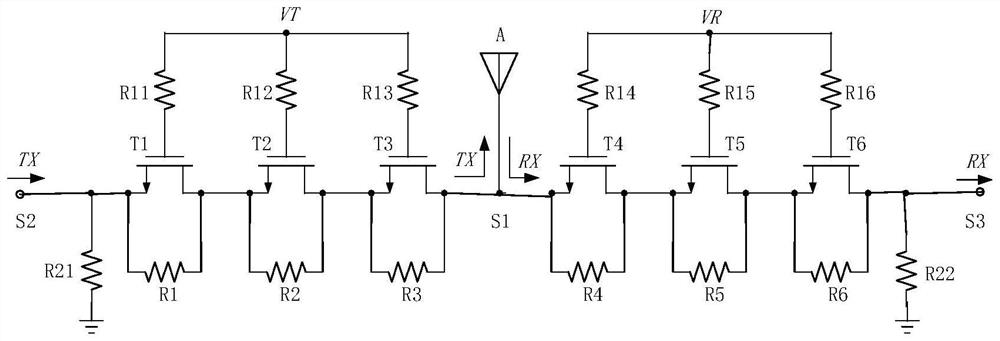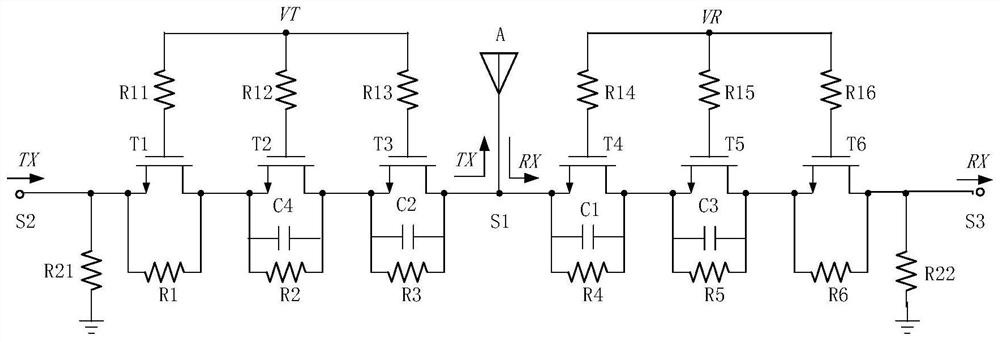SOI CMOS radio frequency switch with high voltage resistance
A radio frequency switch, high withstand voltage technology, applied in the direction of electronic switches, electrical components, pulse technology, etc., can solve the problem of insufficient power carrying capacity of radio frequency switches, and achieve the effect of improving power carrying capacity
- Summary
- Abstract
- Description
- Claims
- Application Information
AI Technical Summary
Problems solved by technology
Method used
Image
Examples
Embodiment 1
[0022] like figure 2 As shown, the radio frequency switch in this embodiment includes an emission channel and a receiving channel. The main path of the transmit channel is from the three switches t1 to T3 of the terminal 2 S2 until the terminal one S1, and the transmit signal Tx moves to the antenna. The main path of the receiving channel is from the three switch tanks T4 to T6 from the terminal one S1 until the terminal three S3, and the received signal RX leaves the antenna. The switch tubes T1 to T6 are all implemented using the SOI CMOS process, such as NMOS devices. A resistor R1, a resistor R2, a compensation capacitor C2, a resistor R3, a compensation capacitor C1 and a resistor R4, a resistor R5, a resistor R6, respectively, a compensation capacitor C1 and a resistor R4, a resistor R5, and a resistor R6, respectively. The gate of the switches t1 to t3 on the main path of the transmit channel is connected to the control voltage a VT by one resistor R11 to R13, respectively....
Embodiment 2
[0026] figure 2 When the radio frequency switch is used, if the RF signal power level of the S2 port is improved, the T5 switch tube T5 will reach the T6 tube to the upper limit of its source drain voltage, which in turn makes the switch tube T5 first breakdown. In view of this, if image 3 As shown, the radio frequency switch in this embodiment includes an emission channel and a receiving channel. The main path of the transmit channel is from the three switches t1 to T3 of the terminal 2 S2 until the terminal one S1, and the transmit signal Tx moves to the antenna. The main path of the receiving channel is from the three switch tanks T4 to T6 from the terminal one S1 until the terminal three S3, and the received signal RX leaves the antenna. The switch tubes T1 to T6 are all implemented using the SOI CMOS process, such as NMOS devices. A resistor R1, a compensation capacitor C4 and a resistor R2, a compensation capacitor C1 and a resistor R3, a compensation capacitor C1 and a res...
Embodiment 3
[0030] The radio frequency switch in the first and seconds can not only be used to switch the emission channel and the reception channel, or it can be used to switch any two channels. See Figure 4 This is a deformed structure of Example 2, schematically with radio frequency signals Tx1 and Tx2 of two different emission channels. Figure 4 The radio frequency switch shown includes a channel one with a channel 2. The main path of the channel is from the three switches t1 to T3 of the terminal two S2 until the terminal one S1, and the signal is transferred to the antenna. The main path of the channel 2 is from the three switch tanks T4 to T6 from the terminal three S3 until the terminal one S1, and the signal two Tx2 moves to the antenna. Figure 4 The principle of implementation of the frequency switches image 3 The displayed frequency switches are the same, and will not be described again.
[0031]In an embodiment from one to three, the main path of each passage is only coupled to th...
PUM
 Login to View More
Login to View More Abstract
Description
Claims
Application Information
 Login to View More
Login to View More - R&D
- Intellectual Property
- Life Sciences
- Materials
- Tech Scout
- Unparalleled Data Quality
- Higher Quality Content
- 60% Fewer Hallucinations
Browse by: Latest US Patents, China's latest patents, Technical Efficacy Thesaurus, Application Domain, Technology Topic, Popular Technical Reports.
© 2025 PatSnap. All rights reserved.Legal|Privacy policy|Modern Slavery Act Transparency Statement|Sitemap|About US| Contact US: help@patsnap.com



